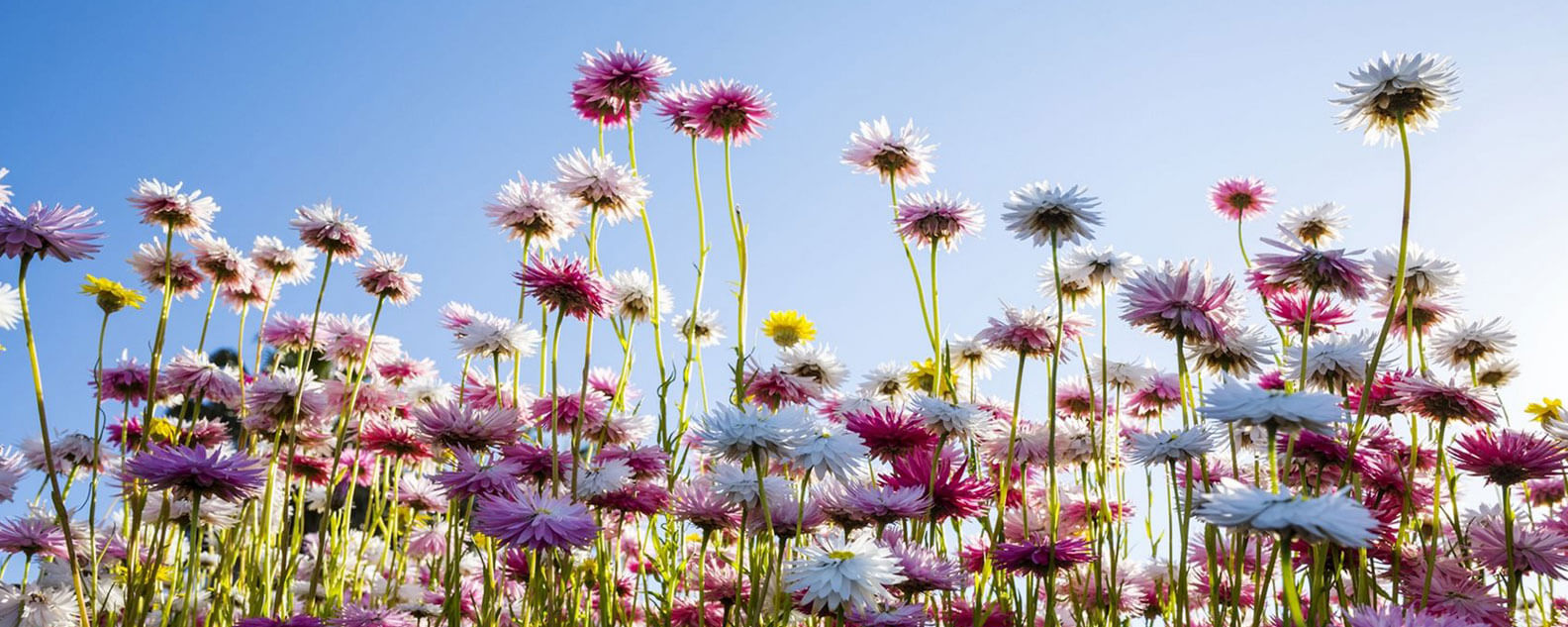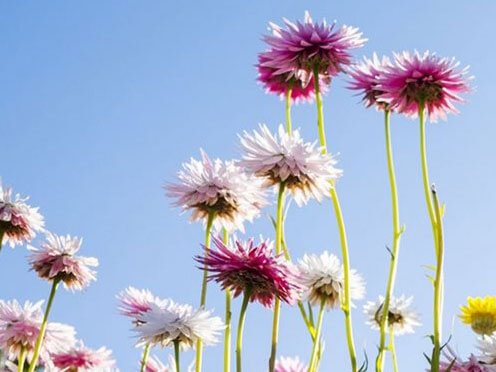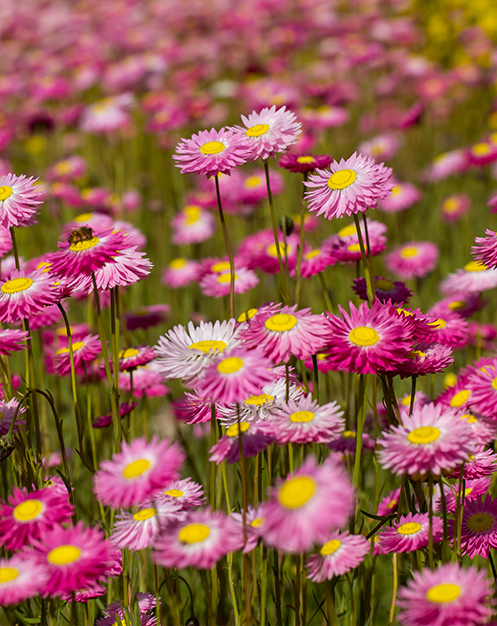Growing Paper Daisies
Every year in spring the Australian native Paper Daisies light up the wildflower season with their dazzling colours. Follow our gardening tips to create your own wildflower garden at home.

The vibrantly coloured Paper Daisy beds at Lakeside and the Connections Garden are one of the most popular features at the Australian Botanic Garden Mount Annan during spring. With some attention to soil preparation and fertilising, there is a good range of species and cultivars that are very responsive to cultivation and rewarding for the home gardener.
Natural habitat
The Paper Daisies that you see flowering at the Australian Botanic Garden Mount Annan during our Wildflower Festival are native to Western Australia, where they carpet huge expanses of some parts of the countryside in spring.
History
William Dampier collected the first Australian daisy, a Brachyscome, in 1699 from Shark Bay in Western Australia. Many Australian daisies were introduced into cultivation in Europe before the middle of the 19th century and they were very popular in the colony from the 1860s until the turn of the century.
Research
Xerochrysum bracteatum is believed to be the first cultivated Australian Daisy and the first of our native plants to be hybridised. German horticulturists hybridised it and released it to European gardeners in the 1850s. Within a decade, many different forms were listed in colonial catalogues.
Paper daisies at the Australian Botanic Garden
Paper Daisies at the Australian Botanic Garden Mount Annan
Planting conditions
Paper Daisies are best grown when you follow the natural growth cycle, which starts with direct sowing in autumn as the soil cools down. Plants will grow slowly through the winter months, developing a strong root system and flowering prolifically in spring. Direct seeding with paper daisies gives you the opportunity to create informal drifts of Australian colour in your garden.
Soil mix
Achieve the best results with a good proportion of washed river sand and good quality potting or soil mix. The soil must be free of weeds, with adequate weed control preferably taking place during the month prior to planting.
With some attention to soil preparation and fertilising, there is a good range of species and cultivars that are very responsive to cultivation and rewarding for the home gardener.
Sowing the seeds
Paper Daisy seeds are very lightweight, so avoid sowing on windy days.
Mix each seed batch separately with half a bucket of normal sand/compost potting mix for each square metre of the garden bed. Work on a rate of 3 grams of seed per square metre. This rate can be reduced if pure seed is purchased. Brachyscomes are sown at a rate of 1 gram per square metre.
Broadcast the seed/soil mix evenly across the surface of the prepared bed. The soil mix will help keep the seed from drying out.
Seed can be direct sown into tubs for a colourful spring display if you have a small garden.
Irrigation
Keep the soil surface moist until germination commences (normally after one week) and apply snail bait or similar control.
Fertiliser
When plants reach a height of 10-15 cm apply a general-purpose liquid fertiliser at three-weekly intervals.
Flowering
The flower display is usually from September through to November depending on sowing time.


The best types of Paper Daisy to grow
To follow are some good types of Paper Daisies to grow in the home garden. You can also dry the flowers and use them in dried flower arrangements.
Rosy Everlastings
Rhodanthe chlorocephala subsp. rosea ‘Rosy Everlasting’
This daisy is native to southwestern Western Australia, usually growing inland from the coast on sandy soils. It is a very popular daisy for cultivation – both in gardens and as a cut flower crop – and reaches a height of around 50 cm. The flowers are small, star-like, deep pink fading to white, with a yellow or black centre.
Sunrays
Rhodanthe manglesii ‘Mangles Everlasting’ or ‘Silver Bells’
This is an attractive Western Australian species that occurs from Kalbarri to the Stirling Range and inland to Coolgardie in open woodland on loamy soils. It was introduced into cultivation in England in 1833 by Captain James Mangles. It is easy to grow and has attractive blue-green foliage. The silvery weeping buds produce beautiful pink or white nodding bell-like paper daisies that have a silky appearance. Sunrays reach a height of around 50 cm.
Other types of Paper Daisy
Showy Everlastings
Schoenia filifolia subsp. subulifolia ‘Showy Everlasting’
This spectacular, vivid yellow paper daisy from southwestern Western Australia is found in coastal and hinterland areas from Geraldton to the south of Perth. It is superb when planted in massed displays and makes an excellent cut flower with contrasting dark green narrow foliage.
Brachyscomes
Swan River Daisies (Brachyscome iberidifolia)
These low-growing plants have dark purple flowers that slowly fade to white – they give the garden a soft dappled look. This Daisy is native to Western Australia, where it grows along watercourses, in swampy areas or chalky hills around Perth. It will grow in both sandy and clay soils, and reach a height of around 20 cm.
It is easy to grow and ideal for borders and tubs. Flowers in massed plantings have a range of colours including white, pink, mauve and blue, which will continue from spring to early summer. Selected colour forms of the Swan River Daisy are also available, such as ‘Summer Skies’ and ‘Bravo Mixed’.
Xerochrysum bracteatum ‘Golden Everlasting’
An extremely variable and widespread plant usually with bright golden yellow flowers. Excellent long-lasting cut flowers. Perennial varieties such as 'Cockatoo,' ‘Diamond Head,’ ‘Dargan Hill Monarch’ and ‘Golden Bowerbird’ are also worth growing.
Senior Horticulturist Stuart Elder on Gardening Australia